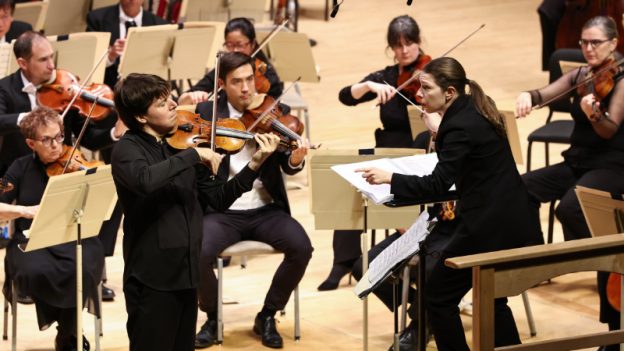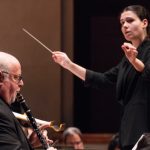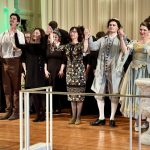November 20, 2025
Boston Symphony Hall
Boston, Massachusetts – USA
Boston Symphony Orchestra; Anna Handler, conductor; Joshua Bell, violin.
Grace-Evangeline MASON: The Imagined Forest
Thomas de HARTMANN: Violin Concerto, Op. 66
Modest Petrovich MUSSORGSKY: Pictures at an Exhibition (orch. Maurice Ravel)
Karl Henning | 24 NOV 2025
In Thursday, November 20, the Boston Symphony Orchestra presented a program that balanced novelty with familiarity under the direction of assistant conductor Anna Handler, with Joshua Bell as soloist. The evening’s sequence—beginning with a Boston première, proceeding to the revival of an overlooked mid-20th-century concerto, and concluding after intermission with Mussorgsky’s Pictures at an Exhibition in Ravel’s orchestration—formed an unusual but thoughtfully conceived architecture, one that invited the listener to engage repertory both new and well-trodden.
West Midlands-born Grace-Evangeline Mason came to the stage to give a brief introduction to her piece, The Imagined Forest, inspired by the work of Berlin-based artist Clare Celeste Börsch. As Börsch uses collage techniques, The Imagined Forest is something of a musical mosaic, opening with a high trumpet note. Some of the material was quite Sibelian, a non-plagiaristic resonance that is apt, considering the number of tone poems by the Finnish master connected to wooded landscapes. I do not say it was obvious, because I do not at all believe that it is, but only a singular instance of a listener who is himself a composer, grasping the piece on the fly. But when I heard a high note in the trumpet, I thought, this could be the end of the piece, bookending the start—and dang if I wasn’t right, Handler and the orchestra presented the piece beautifully.

Composer Grace-Evangeline Mason (left) and BSO associate conductor Anna Handler. (Winslow Townson)
Confession/disclosure: I don’t reserve much patience for the need to be designated a “superstar violinist.” One can practically see the great violinists of the past rolling their eyes in the musical afterlife. I shall gladly stipulate that Mr. Bell is an excellent violinist (else, of course, there would be no need for this review.)
Thomas de Hartmann (born in Ukraine, September 21, 1884 [Old Style], died March 28, 1956, in Princeton). Ahead of the concert, knowing nothing about de Hartmann’s career, the timeline created an interesting anticipation. To compare, Igor Stravinsky was likewise born in Imperial Russia, emigrated at last to the US and died in 1971. Thomas de Hartmann’s concerto (composed in France in 1943) stylistically might be nearly anywhere on the musical map.
The first movement begins with the sort of wind chorale which Antonín Dvořák would have written, had he been born in the twentieth century. Overall, the nature of the collaboration/interaction between the solo violin and orchestra is like that of the great nineteenth-century concertos, which are staples of the repertory. Some orchestral passages of both the first movement and the boisterous Finale might suggest to the listener an affinity with the Khatchaturyan ballets. The “Andante” second movement opens with the soloist singing a rich, poignant mezzo-soprano monody on the G string. The winds sit out the third movement, “Menuet fantasque,” which again feels like a successor to the Dvořák Slavonic Dances. The Concerto is strong, beautiful, fresh, and well redeemed from obscurity. Joshua Bell performed it beautifully, and Maestra Handler and the orchestra collaborated in like vein.
Lastly, as an aside, de Hartmann composed film scores under the pseudonym Thomas Kross. There has got to be a story in that.
Bell came back out for an encore, Chopin’s E-flat Nocturne arranged for violin and orchestra.
The experience had me thinking of nothing so powerfully as of André Rieu.
For the second half of the program, you can hardly get more “butter on mashed potatoes” than Ravel’s orchestration of Musorgsky’s Pictures at an Exhibition. As this was Anna Handler’s first appearance at a subscription concert, it may have been something of a relief to have such a well-known standard to follow a Boston première and the novelty of the de Hartmann. The BSO could possibly play the piece in their sleep, though it is to their credit that they certainly did not. The fact is that Handler and the band brought to this old favorite the level of intensity and attention they would lavish on a new chef-d’œuvre. And, be fair: who would not want to be in the Hall with the BSO brass singing out the “Great Gate at Kiev”? My Russian-born companions, who have not heard the pieces fewer times than I, remarked that the piece never sounded this good to them. ■
EXTERNAL LINKS:
- Boston Symphony Orchestra: bso.org
- Joshua Bell: joshuabell.com
- Yuja Wang: yujawang.com

Read more by Karl Henning.







.png)